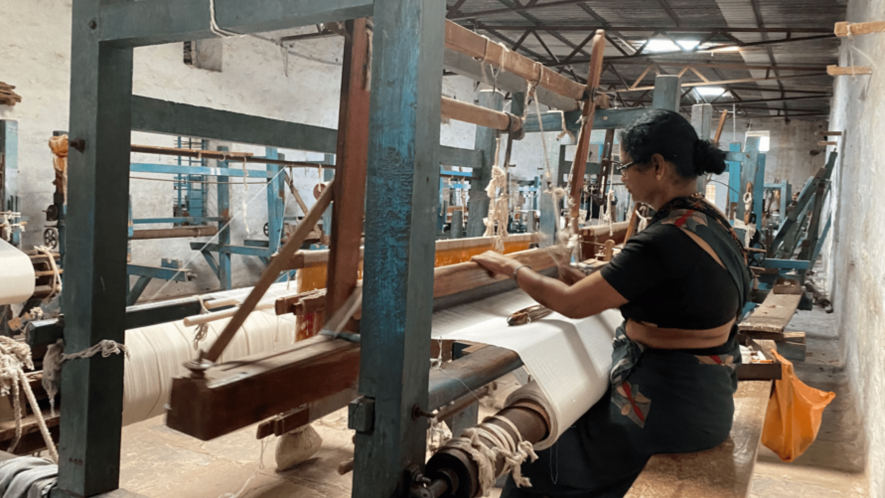Silver Lining to Distress: Opportunities for Karnataka's Handloom Sector

As one exits the gates of the Bengaluru International Airport, the exit area is traditionally decorated with arts and crafts of Karnataka, adorned with a display of grains, spices, and cash crops of the state. On one side of the display is a traditional Ilkal saree in green with a red chikki paras border, and on the other is a Udupi cotton checkered saree in purple draped onto earthen pots. This installation greets special guests to G20 events. The beautiful drapes, although eye-catching, silently cry for attention and draw the informed person to the fast-sinking handloom sector in the state.
Ilkal, Molkalmuru, Kollegal, Udupi sarees, and Kasuti embroidery are well-known handloom crafts of Karnataka. The state has the highest number of GI tags in the handloom sector in the country. While this is laudable, handloom weavers across the state earn just about INR 200 per day, which is three times lower than the basic minimum wage! Highly experienced threaders and weavers work nearly 6-8 hours a day for this pittance of payment, which pays no heed to their skill and experience. And yet, these amazing artisans weave some of the most beautiful sarees, dress materials, towels, stoles, shawls, furnishings, and more.
Handloom weaving is back-breaking work that requires sitting uncomfortably on a mere wooden or metal stool for long hours in poorly lit rooms, which are dingy and devoid of fresh air. Here, workers move their limbs and souls in unison with the complicated movements of their looms and create exquisitely crafted wear. They bear the relentless rattling noise of the looms and are exposed to fine fibre dust. In the process, they are afflicted by respiratory diseases and various musculoskeletal disorders.
Their low wage earnings push them deep into poverty, compelling them to live in and work from tiny houses. There is no room for any savings, and they suffer from their ailments with little or no access to healthcare. As they do not receive any protective health and family insurance or social security measures, the burden of affording healthcare and meeting various expenses keeps them perpetually in poverty. Opportunities to upskill or avail loans so they could also lead a life of dignity are impossible, as such facilities aren't simply available to them. It is a colossal shame that handloom workers live and work in such a terrible state when Prime Minister Narendra Modi exhorts "atma nirbharata," of which handloom weavers are the best epitome.
Clearly, the handloom sector needs attention at every level. Investments, upskilling, capacity building, better infrastructure, health benefits, insurance, the ability to take loans, and special care to incentivise and revitalise the sector are all essential steps so this age-old tradition of living can survive. This is particularly significant given that the handloom sector is completely carbon-neutral, and this was the case long before the idea of a zero-carbon economy even became popular.
The sector depends on natural fibres such as cotton, wool, silk, jute, and, more recently even banana and other plant fibres, which are being employed in weaving cloth and craft. Embedded into the agro-pastoral economy since human civilisation emerged, weaving has worked across seasons and landscapes. Its enterprise increased in the summer months when farm work reduced, supplementing household incomes. This helped artisanal and agro-pastoral communities with added revenues. Over time, such artisanal and economic preoccupations intermingled with local cultures and traditions, distinctly representing them and keeping the sector lively and productive.
This art is typically passed on from one generation to another, particularly within families in most regions. These families practice an apprentice system by which the younger generation learns from their elders techniques of employing colours, developing designs, responding to market demands, and managing supply chains. Just as their elders did, younger generations, too, learn to create unique and unprecedented designs while broadly following the cultural patterns of the trade. Experimenting and specialising with different types of yarns and innovating designs, the community has brought required modifications into their looms, responding to community perceptions and evolving design tastes. All along, these traditions have remained oral and rarely, if ever, have been documented.
With power looms coming into the country during the colonial period and industrial age, handlooms have struggled to survive and have been pushed to the periphery. The fantastic range of handloom-based economies that prospered across the Indian region prior to the East India Company, which was wrecked with horrific colonial policies, has yet managed to survive. In recent decades, this has largely been due to the demand for high-end products such as sarees and dress materials and also because artisans have constantly innovated, creating unique and beautifully intricate designs with such weaves that are simply impractical to recreate on machines.
The science of weaving with handlooms has multiple stages, all involving the handiwork and labour of artisans at every stage. In fact, there are five major stages even before weaving begins. And it is these stages that employ the most labour and create the most livelihoods, particularly crucial for those from backward communities and classes who are below the poverty line. These stages include spinning the raw material on a wheel to make the threads and the twisted yarns. These are then dyed in natural or synthetic colours and dried. The dried yarns are then warped and starched. They are then stretched, laid out, brushed, and straightened to make them stiff. They are then unknotted and quality checked. These steps are crucial as any flaw at any of these stages will make the yarn impossible to weave. And much as it may seem mechanical, these stages demand delicate skills without which there will be nothing to weave. It is these very artisans whose skill and labour are not recognised or acknowledged and have been left out of the state's many supportive schemes and programs. Besides, they aren't even appropriately acknowledged as artisans. They are essentially landless; most don't own a loom and are entirely dependent on daily wages and at the mercy of big weavers. These workers are largely unorganised and neglected and forgotten.
Those owning looms have also suffered from the shift to power looms. Besides, the inertia in the handloom sector, lack of demand for their products, and weak policy support have affected them. Besides the continuing suffering of those who do preparatory work for weaving, even those with looms are suffering the worst economically in recent decades. In many clusters, many seniors who also carry with them the skills of the trade have now shifted to taking unrelated and menial labour to survive, even as they battle occupational diseases they have contracted from working the looms over long periods of their lifetime. With little financial and technological impetus, the extraordinary opportunities of reviving this sector in healthy and productive ways are quickly eroding. This is evident in the looms still working: hotchpotch quick-fix remedies to mechanical hitches in the looms are adopted, such as tying stones, sand bottles, or even heavy stone-filled bags to balance looms and keep weaving going.
According to the Karnataka Economic Survey 2020-2021, the state has 33,677 weaver households. There are also 33,539 handlooms, of which 4,162 are lying idle. The remaining 29,377 handlooms are being operated by 50,574 weavers. In most regions, younger generations have moved away from the craft and migrated to cities in search of better livelihoods. Demonetisation, the introduction of GST, and the Covid pandemic have combined to strike a death knell on this sector. The largely unorganised early-stage artisans, the ones who make and prepare the yarn, have suffered worse than the weavers. Landless weavers have suffered the worst, and in most such families, there is little money and nothing to eat.
Karnataka Chief Minister Siddaramiah, while delivering the 2023-24 Budget, has included various measures promising improvement to the weaving sector. The Budget 2023 introduces three important interventions:
"1) The handloom sector has the potential to provide sustainable employment opportunities by tapping into the booming global market for eco-friendly and natural handwoven fabrics. We will set up a special cell called 'Mahatma Gandhi Vastrodyama' in the textiles department, which will bring together designers, weavers, yarn producers, and allied workers on a common platform. This cell will liaise between the market and various stakeholders and make appropriate interventions for reviving the declining handloom industry in the state.
2) In order to attract higher investments in the North Karnataka region and to generate employment opportunities for locals, action will be taken on priority under the Textile and Garment policy.
3) We will provide free electricity for looms and pre-looms up to a maximum of 250 units of monthly consumption. This will be applicable for units with a maximum of ten HP electricity connections. This will be a step towards the economic independence of the weaving community. These provisions in the budget are a silver lining to the dark clouds hanging over the state's handloom sector and music to the ears of the depressed and oppressed voices."
These are significant steps and must be followed up with rigour and sincerity. A state that has been the leader in making the most major shift to renewables could well be the leader in causing the nationwide revival of the handloom sector as well. This could also make Karnataka's economy a significant contributor to the carbon-neutral economy. Besides, it can help build dignified livelihoods for hundreds of thousands of families.
But this cannot be a piecemeal approach nor one where a one-size-fits-all solution is proposed. The sector has been neglected for decades, as is indicative of the pathetic status of the Karnataka Handloom Development Corporation. Every stream of production, be it cotton, wool, silk, jute, or other natural fibre-based handlooms, is suffering from its own challenges. To revive a close integration of agro-pastoral economies with the handloom economy is critical, and this can be imagined as integrative with ongoing local efforts to protect common property resources such as lakes, grazing pastures, Amrit Mahal Kavals, village forests, etc. By reimagining the revival of the handloom sector, Karnataka can go a long way in achieving several of its climate change mitigation targets.
As the state emerges as an economic powerhouse due to investment and expansion in IT, automobile, manufacturing, and energy sectors, it has gained global recognition. Likewise, it is possible for the historical art of weaving to make the state a global leader. As the global demand for handloom craft increases, this can be supported by rebuilding the handloom economy and ecosystem with deep roots in social justice, socioeconomic equity, and environmental justice. It would also be a step towards reviving demand for weaves connected to the region's rich history and culture.
Handloom can be the material that changes the direction of this century. It can be the material that adorns every officer, leader, student, defence person, corporate worker, and more. It can be the material that adorns every window, every seating surface, and every floor. Just as the new Karnataka budget has helped renew hope in handloom, so too can every part of Karnataka's economic activity work to revive the sector with supportive infrastructure, training, and benefits. This way, those involved in this age-old craft and livelihood can continue to craft their magic and, in the process, rejuvenate local economies. That would be a proper pathway of transformation to sustainability.
(Bhargavi S Rao is a Senior Fellow and Trustee at the Environment Support Group. Views expressed are personal.)
Get the latest reports & analysis with people's perspective on Protests, movements & deep analytical videos, discussions of the current affairs in your Telegram app. Subscribe to NewsClick's Telegram channel & get Real-Time updates on stories, as they get published on our website.
























